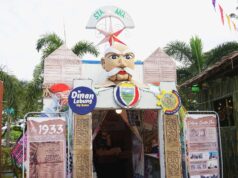CANDABA, Pampanga—A gold medal.
That’s what the 3.14 million tourist arrivals in 2008 meant for the Philippines, an official of the Department of Tourism said here over the weekend.
“That’s a 1.5- percent increase over 2007. It is the smallest ever for the last three or four years. But when the whole world is having negative and some lucky ones have zero growth, 1.5 [percent growth] is a gold medal. It’s an achievement we are very proud of,” Eduardo Jarque, DOT undersecretary for marketing, said in an interview at the sidelines of the bird watching event for the second Ibon-Ebun Festival in this town.
Statistics on the 3.14 million tourists, topped by South Koreans and Americans, were obtained through their disembarkation cards in airports and seaports, he said.
“[Gathering the data] took a little longer last time because we have smaller ports now with direct flights and cruises from various international and domestic destinations,” he said.
The rise in tourist arrivals was not done by the DOT singly. “We have fantastic members of the travel trade, hotel operators, airlines that offer promo rates. We have offered various destinations, joined many travel fairs. Also, local governments are active [in the promotion of tourism] like Candaba,” Jarque said of how the growth was attained.
Asked if the domestic tourism industry would register consistent growth, he replied. “No, no. Everybody says it is expected for a rebound. Give it two years. [The Philippines ] is a good place to be in because our place is stable, the industry is stable. It is expected to grow as we offer more and more products more than ever before.”
The latest come-on among international tourists is bird watching. The first volume of the book “Bird Watching in the Philippines,” prepared by the DOT and the Wild Bird Club of the Philippines, has been promoting St. Paul National Park and Rasa Island in Palawan, Mt. Palay-Palay in Cavite, the coastal lagoon in ParaHaque City, Subic Bay in Zambales, Balanga wetlands in Bataan, Candaba in Pampanga, Hundreds Islands and Bani wetlands in Pangasinan, Olango Island and Alcoy in Cebu and the Philippine Eagle Center in Davao City.
Launched in London last year, the bird watching program will take a second promotional leg there this year.
According to Jarque, the economic crisis also provides opportunities for investors to prepare for better times.
For instance, a Korean company has done a soft launch of the Imperial Hotel in Cebu City last Friday.
The Shangrila on Boracay Island is due to open in April this year.
“With more people working to promote and market Philippine tourism and with more products, the 1.5-percent [growth] should really go up and when the [economy] bounces, we will be more than ready,” Jarque said.
“There’s going to be a renaissance,” he added.
Cesar Cruz, president of the Philippine Tour Operators Association, said that given the history of tourism in the country, the last three years showed “unprecedented growth,” especially when tourist arrivals surpassed the two-million mark in 2006.
For Cruz, the 1.5 percent growth in 2008 was “a big achievement especially given the global crisis.”
Last year’s growth was “difficult to believe” but it did happen because of aggressive promotion, marketing and product development, he said.
“In yesterday’s summit, I said the tourism industry was in a very good position in the last quarter of 2008. The slowdown may be felt in the second quarter. The focus now should be on the domestic market because Filipinos still showed high expenditures in travel and tours. This will be a good transition until we can recover fully from the global crisis,” said Cruz who has been in the industry for more than 20 years.
Foreign tourists are drawn to the Philippines as Thailand , India and Sri Lanka deal with either political turmoil or peace and security issues, he observed.
“The Philippines is the right place to go. We’re stable. We have overcome the perception that our peace and order situation is bad,” Cruz said.
The kidnapping by the Abu Sayyaf of three International Red Cross volunteers in Zamboanga is a matter of explaining Philippine geography to travelers, he added.
That’s what the 3.14 million tourist arrivals in 2008 meant for the Philippines, an official of the Department of Tourism said here over the weekend.
“That’s a 1.5- percent increase over 2007. It is the smallest ever for the last three or four years. But when the whole world is having negative and some lucky ones have zero growth, 1.5 [percent growth] is a gold medal. It’s an achievement we are very proud of,” Eduardo Jarque, DOT undersecretary for marketing, said in an interview at the sidelines of the bird watching event for the second Ibon-Ebun Festival in this town.
Statistics on the 3.14 million tourists, topped by South Koreans and Americans, were obtained through their disembarkation cards in airports and seaports, he said.
“[Gathering the data] took a little longer last time because we have smaller ports now with direct flights and cruises from various international and domestic destinations,” he said.
The rise in tourist arrivals was not done by the DOT singly. “We have fantastic members of the travel trade, hotel operators, airlines that offer promo rates. We have offered various destinations, joined many travel fairs. Also, local governments are active [in the promotion of tourism] like Candaba,” Jarque said of how the growth was attained.
Asked if the domestic tourism industry would register consistent growth, he replied. “No, no. Everybody says it is expected for a rebound. Give it two years. [The Philippines ] is a good place to be in because our place is stable, the industry is stable. It is expected to grow as we offer more and more products more than ever before.”
The latest come-on among international tourists is bird watching. The first volume of the book “Bird Watching in the Philippines,” prepared by the DOT and the Wild Bird Club of the Philippines, has been promoting St. Paul National Park and Rasa Island in Palawan, Mt. Palay-Palay in Cavite, the coastal lagoon in ParaHaque City, Subic Bay in Zambales, Balanga wetlands in Bataan, Candaba in Pampanga, Hundreds Islands and Bani wetlands in Pangasinan, Olango Island and Alcoy in Cebu and the Philippine Eagle Center in Davao City.
Launched in London last year, the bird watching program will take a second promotional leg there this year.
According to Jarque, the economic crisis also provides opportunities for investors to prepare for better times.
For instance, a Korean company has done a soft launch of the Imperial Hotel in Cebu City last Friday.
The Shangrila on Boracay Island is due to open in April this year.
“With more people working to promote and market Philippine tourism and with more products, the 1.5-percent [growth] should really go up and when the [economy] bounces, we will be more than ready,” Jarque said.
“There’s going to be a renaissance,” he added.
Cesar Cruz, president of the Philippine Tour Operators Association, said that given the history of tourism in the country, the last three years showed “unprecedented growth,” especially when tourist arrivals surpassed the two-million mark in 2006.
For Cruz, the 1.5 percent growth in 2008 was “a big achievement especially given the global crisis.”
Last year’s growth was “difficult to believe” but it did happen because of aggressive promotion, marketing and product development, he said.
“In yesterday’s summit, I said the tourism industry was in a very good position in the last quarter of 2008. The slowdown may be felt in the second quarter. The focus now should be on the domestic market because Filipinos still showed high expenditures in travel and tours. This will be a good transition until we can recover fully from the global crisis,” said Cruz who has been in the industry for more than 20 years.
Foreign tourists are drawn to the Philippines as Thailand , India and Sri Lanka deal with either political turmoil or peace and security issues, he observed.
“The Philippines is the right place to go. We’re stable. We have overcome the perception that our peace and order situation is bad,” Cruz said.
The kidnapping by the Abu Sayyaf of three International Red Cross volunteers in Zamboanga is a matter of explaining Philippine geography to travelers, he added.




